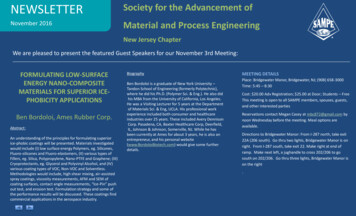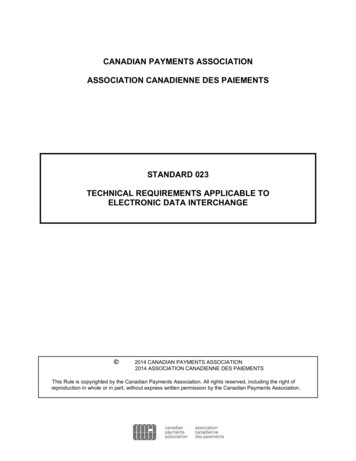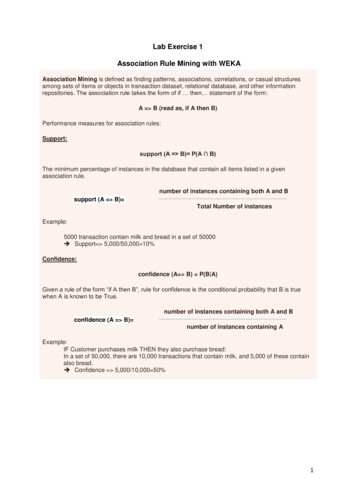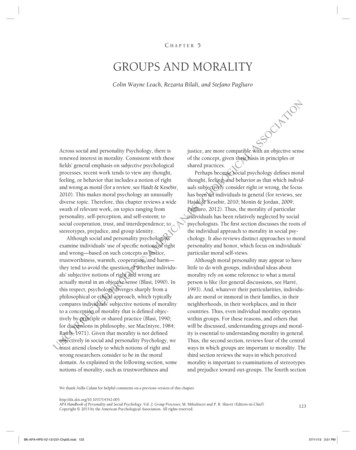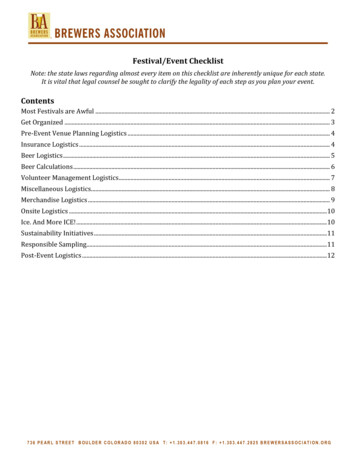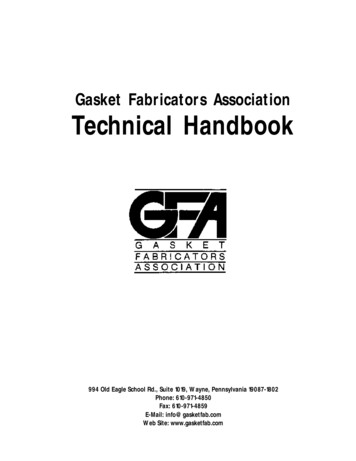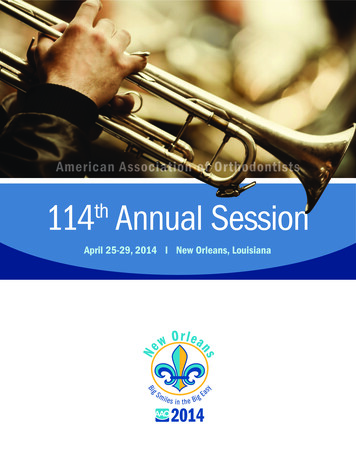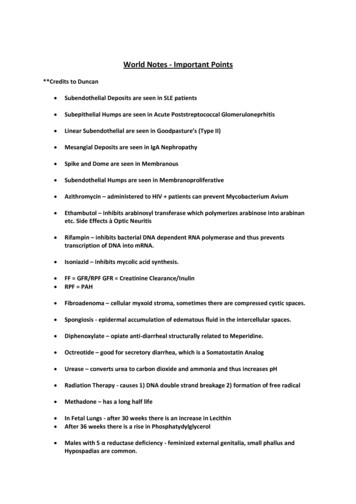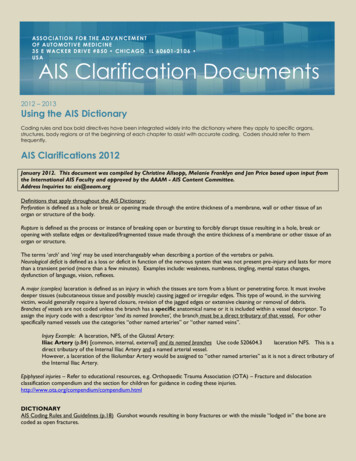
Transcription
AS S O CI AT I O N F O R T H E AD V A N CE M E NTO F AU T O M O T I V E M E D I C I N E3 5 E W A CK E R D R I V E # 8 5 0 C H I C AG O , I L 6 0 6 0 1 - 2 1 0 6 USAW W W . AA AM . O R GAIS Clarification Documents2012 – 2013Using the AIS DictionaryCoding rules and box bold directives have been integrated widely into the dictionary where they apply to specific organs,structures, body regions or at the beginning of each chapter to assist with accurate coding. Coders should refer to themfrequently.AIS Clarifications 2012January 2012. This document was compiled by Christine Allsopp, Melanie Franklyn and Jan Price based upon input fromthe International AIS Faculty and approved by the AAAM - AIS Content Committee.Address Inquiries to: ais@aaam.orgDefinitions that apply throughout the AIS Dictionary:Perforation is defined as a hole or break or opening made through the entire thickness of a membrane, wall or other tissue of anorgan or structure of the body.Rupture is defined as the process or instance of breaking open or bursting to forcibly disrupt tissue resulting in a hole, break oropening with stellate edges or devitalized/fragmented tissue made through the entire thickness of a membrane or other tissue of anorgan or structure.The terms ‘arch’ and ‘ring’ may be used interchangeably when describing a portion of the vertebra or pelvis.Neurological deficit is defined as a loss or deficit in function of the nervous system that was not present pre-injury and lasts for morethan a transient period (more than a few minutes). Examples include: weakness, numbness, tingling, mental status changes,dysfunction of language, vision, reflexes.A major (complex) laceration is defined as an injury in which the tissues are torn from a blunt or penetrating force. It must involvedeeper tissues (subcutaneous tissue and possibly muscle) causing jagged or irregular edges. This type of wound, in the survivingvictim, would generally require a layered closure, revision of the jagged edges or extensive cleaning or removal of debris.Branches of vessels are not coded unless the branch has a specific anatomical name or it is included within a vessel descriptor. Toassign the injury code with a descriptor ‘and its named branches’, the branch must be a direct tributary of that vessel. For otherspecifically named vessels use the categories “other named arteries” or “other named veins”.Injury Example: A laceration, NFS, of the Gluteal Artery:Iliac Artery (p.84) [common, internal, external] and its named branches Use code 520604.3laceration NFS. This is adirect tributary of the Internal Iliac Artery and a named arterial vessel.However, a laceration of the Iliolumbar Artery would be assigned to “other named arteries” as it is not a direct tributary ofthe Internal Iliac Artery.Epiphyseal injuries – Refer to educational resources, e.g. Orthopaedic Trauma Association (OTA) – Fracture and dislocationclassification compendium and the section for children for guidance in coding these htmlDICTIONARYAIS Coding Rules and Guidelines (p.18) Gunshot wounds resulting in bony fractures or with the missile “lodged in” the bone arecoded as open fractures.
PAGE 2AIS CLARIFICATION DOCUMENTSHEADRetroclival hematoma – At this time retroclival hematoma is not a codeable injury in AIS.Vascular injuries (p.32): Vasospasm is a transient occurrence that may or may not show up on imaging. It is the result of injury orinsult to the artery and is not an injury in and of itself. Vasospasm cannot be coded.Hemorrhagic Contusion (Contusional Hematoma) (p45): Code as contusion since 'hemorrhagic’ is the adjective describing thecontusion.Brain edema/swelling (p. 47): The coder should use the terminology used by the local practitioner when deciding whether to codeas edema or swelling. The severities are the same for both.Hypoxic brain damage (p.47): Hypoxic brain damage may be coded in instances where such conditions as hypovolemia or hypoxialead to this damage and the hypoxic brain damage is not directly related to a lesion in the brain. It is possible to have hypoxic braindamage in addition to a lesion within the brain when such lesion would not cause hypoxic brain damage (e.g. small contusions inaddition to hypovolemic shock leading to hypoxic brain damage).Skull fracture (p.49): The temporal bone consists of three portions, the squamous, shell-like portion that is part of the skull vault,and the mastoid and petrous portions which make up part of the skull base. In the rule box describing skull base the word“squamous” should be deleted. In the rule box describing the skull vault, the words “squamous portion only” should be insertedafter the word ‘temporal’.Penetrating injury to skull (p. 31): Any penetrating injury involving the brain stem should be coded to 140216.6 no matter how manyother regions of the brain are also involved.Penetrating injury to cerebellum (p 43) and cerebrum (p47): Penetrating injury to the cerebellum or cerebrum should be measuredfrom the surface of the cerebellum or cerebrum when coding it as 2cm or 2cm. If this cannot be determined, it should be codedusing the inner table of the skull. If the penetrating injury crosses both regions, defer to the ‘penetrating injury 1 area rule.DAI rule box (p. 45): The directions state “If coma exceeds 24 hours and diagnosis meets coding rules for DAI, use 161011.5 .” Theintention is to direct the coder to the Concussive Injury section on p. 51 and, if information about brainstem signs is available, any ofthree codes may be used – 161011.5 or 161012.5 or 161013.5.Concussion/LOC (p. 51): LOC must be documented by a physician, or by a Nurse Practitioner or Physician Assistant or otherrecognized physician extender acting on the behalf of the physician.Loss of consciousness codes (p. 51): LOC may be coded even in the absence of a specific diagnosis of “concussion” as long asthe LOC is documented by a physician, a Nurse Practitioner, Physician Assistant or other recognized physician extender acting onthe behalf of the physician.FACEIris: The uvea is part of the eye, consisting collectively of the iris, the choroid of the eye, and the ciliary body, therefore code irisunder Uvea (p. 58).Mandible fractures (p.59): Multiple mandible fractures receive only one AIS code. The fracture should be assigned to the largestmass area of the mandible that is involved.Orbit (p.62): The lamina papyracea is part of the medial wall of the orbit.Complex Zygoma fractures (p.63): The anatomic area which includes the zygoma is frequently referred to as the“zygomaticomaxillary complex (ZMC)” or the “zygomatic complex”. A fracture in this area may be described as a zygomaticcomplex fracture. The correct code for this is 251800.1. Only if there are additional fracture lines through the main fragment (notminor comminution) and the fracture meets Knight North classification criteria for KN VI, should the code for complex be used.This might be described as a complex fracture of the zygomatic complex.Panfacial (p. 63) - Frontal bone fractures may sometimes be included in the panfacial code and if so, should not be coded separately.
AIS CLARIFICATION DOCUMENTSPAGE 3NECKVascular Injuries (p. 66-67): If the injury is described only as a ‘dissection’ and there is no disruption to the vessel code to intimaltear, no disruption.Salivary gland (p. 70): Parotid gland is included in this code.THORAXHeart (p.77) Code 441012.5 “perforation, ventricular or atrial, with or without tamponade” should read “perforation, eitherventricular or atrial, with or without tamponade” (add word ‘either’)Inhalation injury (p. 80) Inhalation codes include all airway burns from mouth and nose to lungs. Do not code mouth or pharynxseparately.Code 419200.2 “inhalation injury NFS (heat, particulate matter, noxious agents)” should read “heat, particulate matter, caustic ornoxious agents” (add word ‘caustic’)Hemomediastinum (p.81)This code includes mediastinal contusionLung contusions and lacerations (p.78) 'Scattered' lung contusions or lacerations should be coded to the unilateral or bilateral NFScode.Flail chest definition (p. 82) The definition of flail chest should read:“Flail chest” is defined as three or more adjacent ribs, each fractured in more than one location (e.g. posterolateral andanterolateral) to create a free floating segment, which may or may not result in paradoxical chest movement.ABDOMENBladder - Urinary (p.88) Lacerations to the bladder wall that occur outside the peritoneal cavity (extraperitoneal) are commonlyassociated with a fracture of the pelvis. Lacerations to the bladder wall that occur within the peritoneal cavity (intraperitoneal)usually involve the dome of the bladder and the injury generally follows a blow to the abdomen. The following link providesexcellent illustrations: 02.htmlColon (p.89)These codes include injuries to the cecum.Duodenum (p.89) Code 541021.2 “disruption 50% circumference [OIS II] “ should read “perforation, disruption 50%circumference [OIS II] ” (add word ‘perforation’).SPINESpine coding algorithm - To facilitate obtaining the correct code for spinal injuries, the following algorithm is offered:(1) Is the spinal cord involved? ,(2) Is it a contusion/laceration?(3) Is the deficit transient, incomplete or complete?(4) Is there a fracture or dislocation or both?EXTREMITIESUpper / Lower Extremities: Muscle laceration (p.116 & 136) and Muscle tear; avulsion (p.119 & 140):Muscle lacerations occurring from a penetrating / external injury (from the skin down to and including the muscle) are coded to theSkin/subcutaneous/muscle section.Muscle tears and avulsions generally occurring from blunt, stretching-type trauma (sports injury) without an overlying laceration arecoded to the Muscles, Tendon, Ligaments section.
PAGE 4AIS CLARIFICATION DOCUMENTSUPPER EXTREMITYScapula (p. 123) Fractures of the acromion should be coded as 750900.2 Scapula fracture NFS.Humerus (p. 125) The surgical neck of the humerus is located at the junction of the proximal section and the shaft. It should becoded as 751151.2 Proximal humerus - extra-articular. The following link provides an excellent illustration:http://en.wikipedia.org/wiki/Surgical neck of the humerusLOWER EXTREMITYFemur (p. 147) Subtrochanteric fracture should be coded to femur shaft fracture.Distal Tibia (p. 149) Code posterior malleolus to distal tibia.Pelvis (p.159) Malgaigne’s fracture is a vertical shear injury and should be assigned to the section for complete disruption of thepelvic ring.EXTERNAL (Skin) and THERMAL INJURIESBurns (p.165) Sunburn and radiation burns are not currently coded in AIS.OTHER TRAUMA:Hypothermia (p.167) Code hypothermia to whole number temperature only; do not round up or down. For example, 31.7 Cshould be assigned to 010006.3
AIS CLARIFICATION DOCUMENTSPAGE 5AIS Clarifications 2013January 2013. This document was compiled by the AAAM - AIS Content Committee.Address Inquiries to: ais@aaam.orgDefinitions that apply throughout the AIS Dictionary:Vessel dissection should be coded to intimal tear for all vessels including descriptors for carotid artery common/internal, carotidartery external and vertebral artery.DICTIONARYInternal carotid artery: May refer to either AIS Head or Neck chapters;AIS Head codes 121099.3 to 121006.3 "Internal carotid artery" and 320099.9 to 320223.4 "Carotid artery". When the exactlocation of the injury is not specified as to head or neck, code to the neck region with applicable associated detail (laceration,thrombosis, occlusion, etc.).External carotid artery: See also Face chapter which includes branches of the external carotid artery.Vertebral Artery: May refer to either AIS Head or Neck chapters.When the exact location of the injury is not specified as to head or neck, code to the neck region with applicable associated detail(laceration, thrombosis, occlusion, etc).HEADMultiple hematomas / SDH small or large same hemisphere: When multiple small (140640.4) or large (140648.5) hematomas ORwhen multiple small (140652.4) or large (140656.5) SDH are diagnosed, code each individually IF they are separate and individualhematomas / bleeds of the same (unilateral) hemisphere. If both hemispheres are involved use the bilateral code.E.g.: 2 codes would be required forSmall (L) frontal SDH - 140652.4Small (L) occipital SDH - 140652.4Skull – fractured vault 150406.4 (p.49): The descriptor "complex; open with torn, exposed or loss of brain tissue" is meant to read“torn dura”.FACERetrobulbar haemorrhage: Use code 240499.1 - Eye – NFS (p.56).Nose amputation: Code as a skin avulsion according to its level of severity (p.54).“Displacement must be significant”: For mandible fractures and nasal fractures, code the description “minimally displaced” as nondisplaced.LeFort fractures are coded as per the LeFort definitions (p. 61). Medical documentation indicating appropriate LeFort bone fracturesmay qualify for LeFort fracture coding when the word “LeFort” is not explicitly used in the documentation.Panfacial fractures: Multiple and complex bilateral fractures of the face not conforming to the standard classifications of LeFortbut resulting in significant deformation and meeting the pan facial fracture definition (p. 63) should be coded using the panfacial codes251900.3 / 251902.4.
PAGE 6AIS CLARIFICATION DOCUMENTSTHORAXSkin / subcutaneous / muscle injuries described as ‘degloving’ should be coded as avulsion (p.72).Intracardiac chordae tendineae 440400.5 (p.78) includes papillary muscle injury.Thoracic injuries (p. 81) – The 1000cc blood loss descriptor is meant to indicate blood loss of 20% in the individual. When codingpediatric or other individuals with smaller blood volumes use 20% blood loss parameter instead of 1000cc.Thoracic Injury NFS 442299.9 (p.81) refers to Thoracic cavity injury.Traumatic Pneumatocele: This is a sequlae resulting from injury and cannot be coded at this time. Documentation of a specificpulmonary injury should be pursued.ABDOMENSkin / subcutaneous / muscle injuries described as ‘degloving’ should be coded as avulsion (p.83).SPINECauda equina laceration: Cauda equina injuries described as laceration should be coded under cauda equina contusion.The following change was included inadvertently when originally published in 2013 and should not be implementedat this time.If spinal fractures and dislocations occur together without associated cord injuries code the fracture and the dislocation separately.E.g.: Dislocation C4/5 and fracture C4 vertebral body (no cord involvement)650230.2 – Fracture with no cord involvement – vertebral body NFS (“burst fracture”)650204.2 - Dislocation [subluxation] with no cord involvementCoding rule: – code dislocation to superior vertebra.If there is spinal cord compression or epidural/subdural hemorrhage but no neurologic deficit along with an associated fracture, codethe spinal cord injury as NFS and the fracture as if there was no cord involvement.Lateral mass: Lateral mass fractures should be coded as pedicle fractures.EXTREMITY (Upper and Lower)“Fracture and Dislocation Compendium” which provides information and additional illustrations of various fractures is available fromthe Orthopaediac Trauma Association (OTA) educational resources – www.ota.orgUPPER EXTREMITYLigament injuries to named ligaments in the upper extremity should be coded as a sprain in the associated joint.LOWER EXTREMITYFoot dislocations include talonavicular, calcaneocubiod, talocalcaneal, and metatarsal-phalangeal dislocations.874030.2 Knee joint dislocation (p.141) includes patellar dislocation (knee joint consists of proximal tibia, distal femur and patella).854351.2 Distal Tibia fracture (p.149) includes isolated or associated posterior malleolus.856100.2 Pelvic ring fracture (p.159) includes "pelvic ring dislocation".Pelvic fracture codes (p.159) incomplete or complete disruption with blood loss:Blood loss 20% by volume may be used for documented small / moderate pelvic hematomaBlood loss 20% by volume may be used for documented large / extensive pelvic hematomaThe following chart may be helpful in coding pelvic fractures:
AIS CLARIFICATION DOCUMENTSPAGE 7Pelvic Ring Fracture Stability and Medical Documentation / AIS Code ApplicabilitySTABLEIsolated simple fracture of:Pubic ramusIliumIschiumSacral alaTransverse fracture of sacrum andcoccyx – with or withoutsacrococcygeal dislocationMinor symphysis pubis separation ( 2.5 cm)Tile Classification - AOTA Classification - AYoung/Burgess Classification – AP1PARTIALLY UNSTABLETOTALLY UNSTABLEWide symphysis pubisSeparation ( 2.5 cm)Public ramus fracture withsacroiliac fracture/dislocationAnterior compression fracture of sacrumFracture involving posterior archwith complete loss of posteriorosteoligamentous integrityFracture involving posterior archwith pelvic floor disruptionFracture involving posterior arch withposterior ligamentous integrity partiallymaintainedFracture involving posterior arch, butpelvic floor intactBilateral fractures with posteriorligamentous integrity partiallymaintainedTile Classification – BOTA Classification – BYoung/Burgess Classification – LC1, LC2and AP2Sacroiliac joint with anterior disruption“Open book” fracture 2.5 cmTile Classification - COTA Classification – CYoung/Burgess Classification –LC3, AP3 and VSVertical shearMalgaigne fractureSacroiliac joint with posteriordisruptionAcetabular FracturesPARTIAL ARTICULAR One ColumnPosterior WallPosterior ColumnAnterior ColumnAnterior WallPosterior Column with Posterior WallPARTIAL ARTICULAR - TransverseCOMPLETE ARTICULAR Both ColumnsTransverseT-ShapedAnterior Column, PosteriorHemitransverseTransverse with Posterior WallTransverse with Posterior WallBoth ColumnsOTHER TRAUMACaustic Agents (p.166) includes noxious agents.Carbon monoxide poisoning is not an injury, therefore it is not coded.020006.5 – Asphyxia / Suffocation (p.166)060006.5 – Drowning (p.166)080004.5 – Electrical Injury (p.166)"with cardiac arrest documented by medical personnel” includes documentation from EMS orpre-hospital personnel.
AIS Coding Rules and Guidelines (p.18) Gunshot wounds resulting in bony fractures or with the missile “lodged in” the bone are coded as open fractures. AIS Clarification Documents ASSOCIATION FOR THE ADVANCEMENT OF AUTOMOTIVE MEDICINE 35 E WACKER DRIVE #850 CHICAGO, IL 60601-2106
